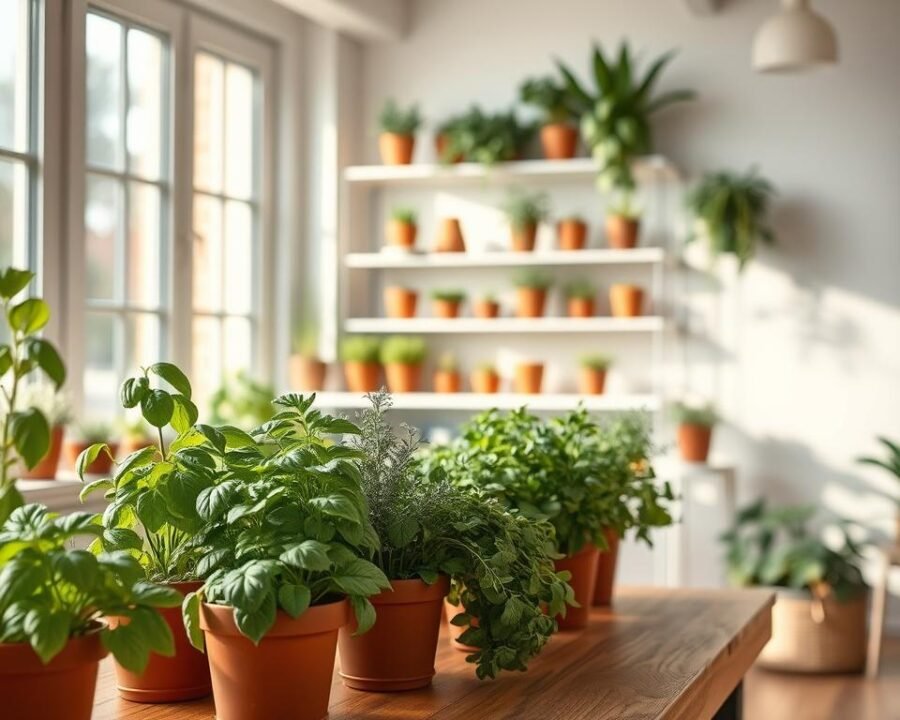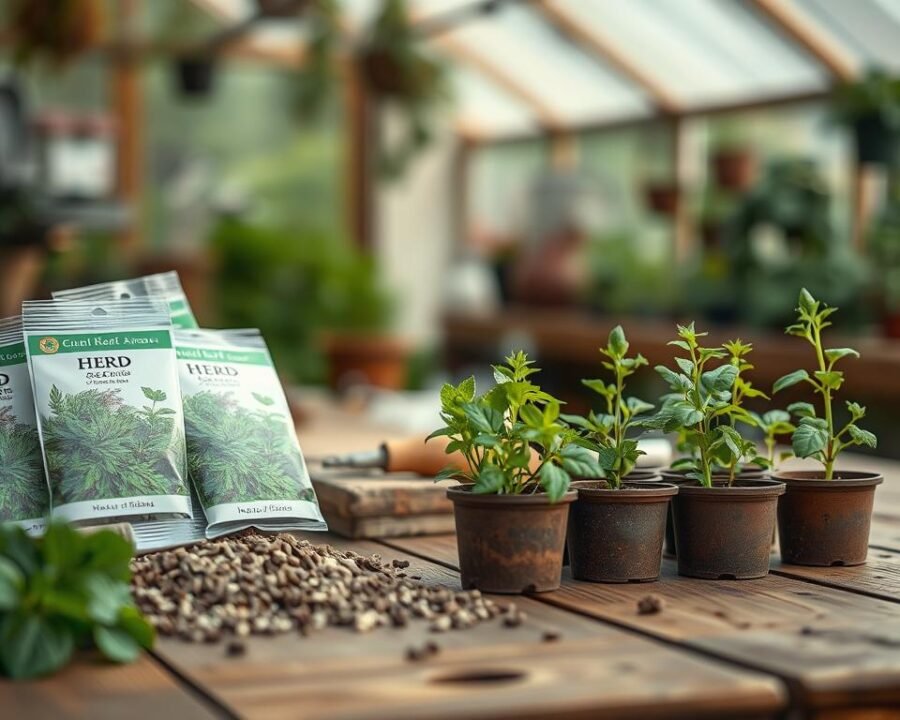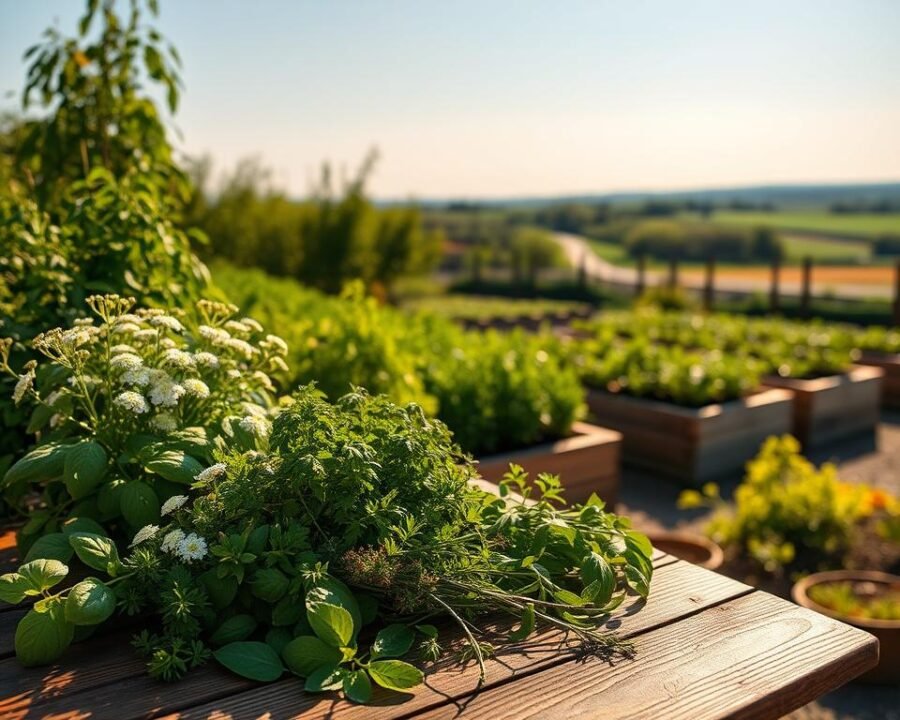How to Grow Herbs for Plants Everyone Is Using: Our Guide
There’s something magical about snipping fresh leaves straight from your own herb garden. Whether you’re seasoning a dish or brewing tea, homegrown flavors elevate every meal. Best of all, you don’t need a backyard—just a sunny windowsill or balcony.
We’ve all bought store-bought bundles only to watch them wilt. But with a few pots and seeds, you can enjoy year-round freshness. Start with forgiving varieties like basil or chives—they thrive with minimal effort.
Imagine stepping outside to grab aromatic mint for your iced tea or thyme for roasted veggies. No more last-minute grocery runs. Just vibrant, easy-grow greens ready whenever you need them.
Key Takeaways
- Herb gardens fit small spaces like balconies or windowsills.
- Beginner-friendly options include basil, chives, and mint.
- Homegrown herbs taste better and save money.
- No garden? Containers work perfectly.
- Fresh picks enhance meals instantly.
Why Grow Your Own Herbs? Fresh Flavors at Your Fingertips
Fresh flavors burst to life when plucked straight from your windowsill. Unlike supermarket bundles, homegrown greens pack intense aromas and tastes. Plus, they save you money—74% less over six months compared to store-bought.
Save Money, Elevate Every Meal
Store shelves charge premium prices for wilted parsley or dried basil. A single $3 packet of seeds yields months of harvests. See how costs stack up:
| Herb | Store-Bought (6 Months) | Homegrown (6 Months) |
|---|---|---|
| Basil | $24 | $6 |
| Mint | $18 | $4 |
| Thyme | $21 | $5 |
Freshly picked leaves also retain 40% more essential oils, amplifying flavors. Imagine summer tomatoes with just-cut basil or winter stews with earthy rosemary.
Harvest Anytime, Any Season
Outdoor gardens fade in winter, but indoor pots thrive year-round. We’ve brewed mint tea during snowstorms and clipped chives for omelets in January. No more bland dried substitutes.
Herbs do more than flavor food—they enliven your space. Lavender calms, citrusy lemongrass energizes, and spicy oregano fills the home with warmth. Every season offers new pairings:
- Summer: Basil in caprese salads.
- Fall: Sage browned butter pasta.
- Winter: Thyme-infused roasted roots.
- Spring: Dill over asparagus.
How to Grow Herbs for Plants Everyone Is Using
Transform your meals with vibrant flavors straight from your windowsill. The right picks turn a small space into a flavor powerhouse. Start by matching greens to your cooking habits and sunlight availability.
Choosing the Right Herbs for Your Lifestyle
Ask yourself: What do I cook most? Italian dishes thrive with basil, while Asian cuisine shines with cilantro. Limited space? Compact varieties like chives or thyme fit snugly on countertops.
For busy schedules, opt for low-maintenance perennial herbs like rosemary or oregano. They regrow yearly with minimal care. Love teas? Lemon balm adds citrusy notes and repels deer naturally.
Basil, Mint, and Other Kitchen Favorites
Basil grows fast but needs bright light indoors. Harvest leaves weekly to encourage bushiness. Pair it with tomatoes or blend into pesto.
Mint spreads aggressively—plant it solo in containers. Snip leaves often to control growth. Perfect for mojitos or garnishing desserts.
Other versatile picks:
- Parsley: Biennial, ideal for garnishes.
- Thyme: Drought-tolerant, great for roasts.
- Cilantro: Quick harvest (3–4 weeks).
Pro tip: Group herbs with similar water needs. Mediterranean varieties (rosemary, sage) prefer drier soil, while basil and mint crave moisture.
Indoor vs. Outdoor Herb Gardening: What Works Best?
Bright sunlight or cozy corners—herbs adapt to your space with surprising flexibility. Whether you’re working with a sunny patio or a north-facing apartment, strategic choices ensure lush growth.

Sunlight and Space Requirements
Light fuels flavor. Rosemary and sage demand 6+ hours of direct sun, while parsley tolerates shade. Measure your space’s lumens—herbs thrive between 2,500–5,000 lux indoors.
“South-facing windows deliver the strongest light, ideal for Mediterranean varieties.”
Vertical systems maximize tight spots. Wall planters or stacked pots let you grow upward, saving counter space.
Herbs That Thrive Indoors (And Ones That Don’t)
These greens excel inside year-round:
- Thyme: Drought-resistant and compact.
- Winter savory: Prefers cooler indoor temps.
- Chives: Tolerate low light.
Skip these for indoor setups—they’ll disappoint:
- Basil (needs intense light).
- Summer savory (fails without full sun).
- Dill (too tall and leggy).
| Herb | Light Needs (Lux) | Temp Range (°F) |
|---|---|---|
| Oregano | 4,000+ | 65–75 |
| Mint | 3,000 | 60–70 |
| Cilantro | 2,500 | 50–75 |
In winter, supplement with grow lights. Most greens stall below 50°F but rebound when warmth returns.
Setting Up Your Herb Garden: Containers, Soil, and Tools
Healthy roots start with smart container and soil choices. Whether you’re planting mint or thyme, the right foundation ensures vibrant growth. Let’s compare options and share pro tips.

Pots vs. Ground Planting: Pros and Cons
Containers offer flexibility, especially for invasive varieties like mint. Use 12″ wide pots to manage runners. Terra cotta reduces overwatering risks by 40% thanks to breathable walls.
Ground planting suits sprawling herbs like rosemary. But it lacks control over soil quality and drainage. Here’s a quick comparison:
| Feature | Pots | Ground |
|---|---|---|
| Space Control | High | Low |
| Drainage | Adjustable | Variable |
| Mobility | Easy | None |
The Best Soil Mix for Lush Growth
Organic blends with 30% compost boost flavor intensity. Mediterranean herbs (rosemary, oregano) prefer gritty mixes, while basil thrives in moisture-retentive blends.
Try these recipes:
| Herb Type | Soil Mix | pH |
|---|---|---|
| Basil/Mint | 50% potting soil, 30% compost, 20% perlite | 6.0–7.5 |
| Rosemary/Thyme | 60% sand, 30% soil, 10% compost | 6.0–8.0 |
Pro tip: Test drainage by watering empty pots. If water pools, add perlite.
Tool Checklist Under $50
- Pruners ($12): For clean cuts.
- Moisture meter ($10): Prevents overwatering.
- pH tester ($15): Balances soil nutrients.
Planting Herbs from Seeds vs. Starter Plants
Quick results or long-term projects—herbs adapt to your pace. Choosing between seeds and starters depends on your timeline and patience. Some varieties sprout in days, while others take weeks to show progress.

Fast-Growing Herbs for Impatient Gardeners
Chives win the speed race, sprouting in 7–10 days. Parsley lags behind at 14–21 days. For quick wins, prioritize these high-germination picks:
- Basil: 5–10 days with warmth.
- Cilantro: Ready to harvest in 3 weeks.
- Dill: Thrives in deep pots (taproots need space).
“Cluster seeds 1 inch apart for airflow. Crowding invites mold.”
| Herb | Germination Time | Harvest Ready |
|---|---|---|
| Chives | 7–10 days | 60 days |
| Basil | 5–10 days | 30 days |
| Dill | 10–14 days | 45 days |
Tips for Transplanting Store-Bought Herbs
Supermarket basil often suffers from shock. Acclimate it gradually—2 hours of morning sun for 3 days before full exposure. Follow this way to ensure success:
- Loosen roots gently.
- Plant in a container 2 inches wider.
- Water deeply, then skip 2 days.
*Pro tip*: Hardening off takes 7 days. Move outdoor transplants outside for longer periods daily.
Watering and Feeding Your Herbs: Avoiding Common Mistakes
Mastering moisture levels makes all the difference between thriving greens and struggling sprouts. Too much water drowns roots, while too little stunts growth. Learn to read your plant’s cues—crispy edges or drooping stems never lie.
Find the Sweet Spot for Hydration
Stick a finger 1 inch into the soil. If it’s dry, it’s time to hydrate. Mint craves dampness daily, but thyme thrives on neglect. Here’s how often popular varieties need drinks:
- Basil: Every 2–3 days (check topsoil).
- Rosemary: Weekly—let soil dry completely.
- Parsley: 3x weekly; keep evenly moist.
“Overwatered basil yellows from the bottom up. Underwatered sage curls its leaves inward.”
Boost Flavor With Organic Nutrients
Worm castings amplify essential oils by 25%, deepening aromas. Try these kitchen-scrap fertilizers:
- Banana peel tea: Soak peels for 48 hours—rich in potassium.
- Eggshell powder: Crush dried shells for calcium.
- Compost steep: Brew compost in water for 24 hours.
Match NPK ratios to growth stages:
| Stage | N-P-K | Best For |
|---|---|---|
| Seedling | 5-1-1 | Leaf development |
| Mature | 2-3-3 | Flowering/fruiting |
For vacations, set up drip irrigation with a timer. A $20 kit keeps soil perfectly damp for up to 10 days.
Pruning and Harvesting for Continuous Growth
Sharp scissors and smart timing keep your garden productive all season. Regular trimming shapes plants and boosts yields. The right techniques ensure fresh flavors without exhausting your greens.
Where to Cut for Bushier Plants
Snip just above leaf nodes to encourage lateral growth. This way, stems branch out instead of growing tall and leggy. Basil and mint respond especially well to frequent pinching.
Follow these steps for optimal results:
- Identify healthy nodes (where leaves meet stems).
- Cut at a 45° angle ¼ inch above the node.
- Remove no more than ⅓ of the plant at once.
“Morning pruning reduces stress—plants heal faster when hydrated.”
| Herb | Pruning Frequency | Best Time to Harvest |
|---|---|---|
| Basil | Weekly | Before flowering |
| Oregano | Biweekly | Oil peaks pre-bloom |
| Thyme | Monthly | Mid-morning |
Preserving Excess Herbs
Freezing locks in freshness better than drying for tender varieties like mint. For woody stems (rosemary, thyme), air-drying retains potency. Compare methods:
- Freezing: Chop leaves, pack in ice cube trays with water.
- Drying: Hang bundles upside down in a dark, ventilated area.
- Oils: Steep in olive oil for 2–4 weeks.
Succession planting ensures nonstop harvests. Sow new seeds every 3 weeks for a steady supply. Pair this with proper storage to enjoy summer flavors year-round.
Troubleshooting: Pests, Diseases, and Winter Care
Even the healthiest greens face challenges. Spotting issues early keeps your harvests abundant. With simple fixes, you can protect your garden from invaders and cold snaps.
Natural Pest Control Solutions
Neem oil stops 85% of common invaders when used weekly. This organic solution smothers pests without harming plants. For stubborn aphids, try this garlic spray:
- Blend 3 garlic cloves with 1 cup water.
- Strain and mix with 1 tsp dish soap.
- Spritz leaves every 3 days until clear.
Top offenders and organic fixes:
- Whiteflies: Yellow sticky traps catch adults.
- Spider mites: Mist leaves daily to disrupt webs.
- Slugs: Diatomaceous earth barriers work best.
“Prevent infestations by spacing plants for airflow. Crowding invites trouble.”
Overwintering Perennial Herbs
Rosemary withstands 20°F frosts with proper mulch. Protect roots with these steps:
| Herb | Winter Prep | Success Rate |
|---|---|---|
| Thyme | Trim by ⅓, add straw | 90% |
| Sage | Move pots indoors | 75% |
| Lavender | Cover with burlap | 65% |
Indoor setups need adjustments:
- Reduce watering by 50% in low light.
- Wipe leaves monthly to prevent diseases.
- Rotate pots weekly for even growth.
Greenhouses maintain 40°F minimum—ideal for Mediterranean varieties. Windowsills work for hardier types like chives.
Conclusion: Start Small and Savor the Process
Small steps lead to big rewards in cultivating fresh flavors. A herb garden thrives when you begin with just a few pots—92% of beginners succeed with 3–5 varieties. In about 21 days, you’ll snip your first harvest.
Share cuttings with neighbors or join local gardening groups. One gardener transformed their kitchen windowsill into a mint oasis, inspiring friends to try growing herbs too.
Ready for more? Experiment with herb-infused oils or dried blends. Every leaf tells a story of patience and care.
- Easy-grow picks like basil and chives build confidence.
- Swap plants to discover new flavors.
- Celebrate progress—each snip is a win.







